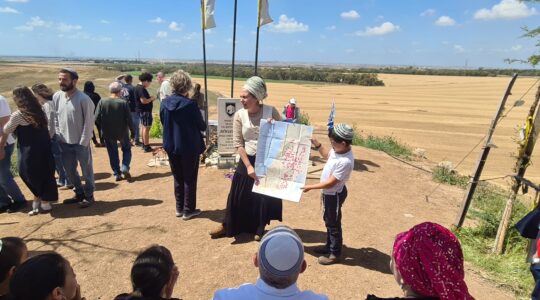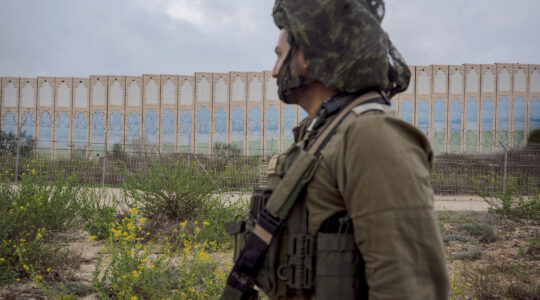
JTA PHOTOS: With big plans, Beersheva is hoping to bloom in the Negev
Patrons eating lunch in a row of recently opened restaurants on the ground floor of public housing in central Beersheva. (Ben Sales/JTA)
BEERSHEVA, Israel (JTA) – In four years, it’s slated to be bigger than New York’s Central Park and consist of open fields, a sports complex, and a lake and a river filled with recycled water.
Now, though, Beersheva River Park looks like much of the area surrounding the desert city of Beersheva: a panorama of sand and dirt, with a bit of trash and, on a good day, some dirty water trickling through a gorge.
In one patch of empty space, workers in hard hats walk up and down rows of stadium seats covered in plastic. At the bottom is a round stage with the foundations of a back wall that is scheduled to open in October as a 12,000-seat amphitheater — Israel’s largest. The cost is $16 million.
Alongside the park, Beersheva looks like one large construction zone. Cranes towering above rising skyscrapers dot the sky. Museums and restaurants are popping up near a formerly dilapidated central district. Ten new upscale suburbs are in the works north of the city. The Israeli Defense Forces is building a massive training complex with seven bases next door.
On Sunday, the Israeli government announced a five-year initiative to invest nearly $140 million into bringing new residents and businesses to the Negev Desert.
“The city is waking up,” says Natan Jibli, CEO of Israel’s Negev Development Authority. “There’s culture and things to do and students and artists.”
Israelis long have viewed Beersheva as the country’s largest “development town,” the first and sometimes only stop for immigrants from Morocco, Ethiopia, India or Russia. Squat brown public housing known simply as “residences” crowd neighborhoods devoid of names and identified only by a series of letters.
In its outer districts, though, Beersheva features rolling green hills — even in July — trees, single-family homes and traffic circles anchored by central fountains.

The future synagogue of Karmit, the only structure built so far in a Beersheva suburb that developers hope will one day attract up to 2,500 families.(Ben Sales/JTA)
In its Old City, which dates back to 19th-century Turkish rule, dilapidated buildings are now buffeted by sleek apartments and trendy restaurants opening on the ground levels of many peeling residences. Some of the apartments house students at Ben-Gurion University of the Negev, a bustling campus in northern Beersheva with smooth concrete buildings.
More than 100 of the students live in apartments subsidized by the school, and in return they give eight hours per week to their community in the form of volunteer programs. University officials hope to engage the students in the city — and keep them there after they graduate.
“The university was created with a mandate to bring development to the region,” said Faye Bittker, director of the university’s department of publications and media relations. “We want to build an ecosystem. You have academia, the army, high-tech and a hospital.”
The university boasts a well-regarded computer engineering program and is pinning its hopes on a new high-tech park next door. The first of the park’s 20 planned buildings opened this month and houses seven companies along with two incubators for early-stage startups. When completed, the park will house up to 60 companies, bringing 10,000 jobs to the area.
“The park is big technology news for Beersheva and the Negev,” said Sima Kachlon, general manager of the city’s Proactive Center for Business Promotion. “You finish an engineering degree and you have somewhere to join.”
The center also hopes to attract large communications and electric companies to Beersheva and create a commercial district in the Old City. Kachlon laments that chain clothing stores and cafes have been reluctant to open in a city some still regard as backwater.
For upper- and middle-class Israelis still wary of Beersheva, the government has planned 10 new suburbs to the city’s north: affordable, quiet bedroom communities for people working in Beersheva or even Tel Aviv, which is about one hour, 15 minutes away by car and an hour by train.
The Jewish National Fund in the past 10 years has invested $40 million into attracting half a million Israelis here within two decades, working alongside the Or Movement, which shares that goal. The Israeli immigration organization Nefesh B’Nefesh also has offered incentives to families who move to Israel’s South.
In past decades, “the state took initiative, but now, as we see on Facebook, innovation comes from the people and the young generation,” said Roni Flamer, CEO of the Or Movement. “If you know how to create a good model, the state will see it.”

The amphitheater at Beersheva River Park, set to open this year, will seat up to 12,000 people.(Ben Sales/JTA)
To attract residents to Beersheva, the government is improving its connections to Tel Aviv. A new train track will carry passengers between the cities in 50 minutes, and the Negev Development Authority is pushing to build Israel’s second international airport in the area even though Beersheva has few hotels.
Like Beersheva River Park, some of the planned communities still leave much to the imagination.
One planned town, Karmit, has one structure, the synagogue — it was paid for by American donors. JNF envisions the town with 2,500 families, half religious and half secular, and is counting on existing infrastructure like the synagogue attracting prospective buyers. Karmit’s first lots won’t be populated until 2016.
The 10-suburb plan has its critics. Ronit Ze’evi, Beersheva’s district manager for the Society for the Protection of Nature in Israel, says she’d prefer that neighborhoods be added instead to nearby depressed towns. The new suburbs, she said, will separate the upper and lower classes while costing the government more money in infrastructure development.
“They’ll hurt the existing towns,” Ze’evi said. “If you have communities of villas, the well-off population will leave the city and go to these villas. It’s less socially equitable.”
Fifty families — a progressive Orthodox community equal parts immigrant and native-born Israeli — has settled in the heart of Beersheva. Since arriving in 2010, they’ve tried to boost the district socially and religiously, volunteering in immigrant absorption centers, hosting lectures and social events, and founding a liberal Orthodox prayer group.
“What makes us different is being a progressive religious community,” said Ravit Greenberg, former chairwoman of the community’s board. “When you go into a school and say pluralism matters to us, you’re doing something important.”
Beersheva’s biggest boost may come from the new IDF training base complex, which is set to arrive by 2015, along with the army’s computer unit. The army estimates that this will streamline its operations and create 10,000 jobs.
Ben-Gurion University plans to collaborate with the army on research and courses, and will encourage soldiers to find jobs here after their discharge.
As with many projects, Beersheva residents will have to wait and see what happens. But for Flamer, who noted that the Negev Desert covers most of Israel, a new and improved city is just on the horizon.
“We’re talking about the state’s biggest dream,” Flamer said, “to affect the whole population, to take 60 percent of Israel and make it 100 percent of its future.”
JTA has documented Jewish history in real-time for over a century. Keep our journalism strong by joining us in supporting independent, award-winning reporting.





